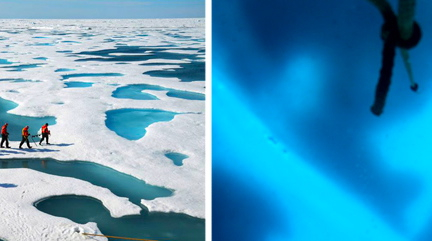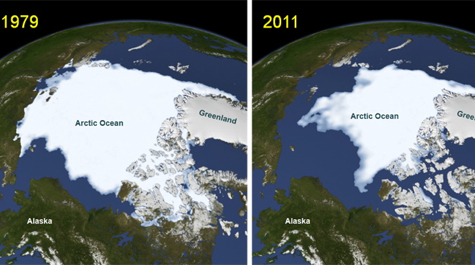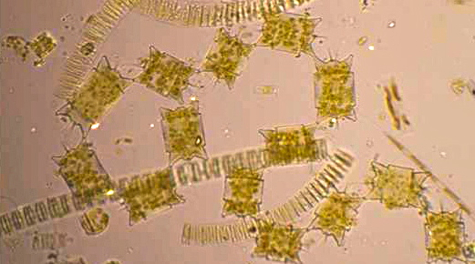Smith helps announce NASA discovery of unprecedented blooms of ocean life
Professor Walker Smith of the Virginia Institute of Marine Science helped announce a major oceanographic research finding during a NASA media teleconference on June 7th, providing independent expertise regarding a biological discovery in the Arctic Ocean that scientists say is “as dramatic and unexpected as finding a rainforest in the middle of a desert.”
The discovery was made during a NASA-sponsored ICESCAPE expedition in the summer of 2011, when researchers punched through 3-foot-thick sea ice to find waters richer in microscopic marine plants, essential to all sea life, than any other ocean region on Earth.
The finding reveals a new consequence of the Arctic's warming climate and provides an important clue to understanding the impacts of a changing climate and environment on the Arctic Ocean and its ecology.
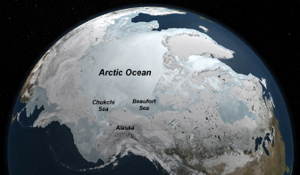
The ICESCAPE expedition (for Impacts of Climate on EcoSystems and Chemistry of the Arctic Pacific Environment) explored Arctic waters in the Beaufort and Chukchi seas along Alaska's western and northern coasts onboard a U.S. Coast Guard icebreaker. During the July 2011 Chukchi Sea leg of ICESCAPE, the researchers observed blooms beneath the ice that extended from the sea-ice edge to 72 miles into the ice pack.
"We embarked on ICESCAPE to validate our satellite ocean-observing data in an area of the Earth that is very difficult to get to," says Paula Bontempi, NASA's ocean biology and biogeochemistry program manager in Washington. "We wound up making a discovery that hopefully will help researchers and resource managers better understand the Arctic."
The microscopic plants, called phytoplankton, are the base of the marine food chain. Phytoplankton were thought to grow in the Arctic Ocean only after sea ice had retreated for the summer. Scientists now think that the thinning Arctic ice is allowing sunlight to reach the waters under the sea ice, catalyzing the plant blooms where they had never been observed and were in fact not expected. The findings were published in the June 7th issue of the journal Science.
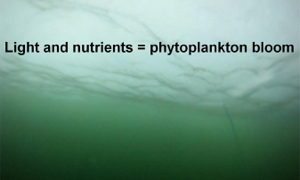
"If someone had asked me before the expedition whether we would see under-ice blooms, I would have told them it was impossible," said Kevin Arrigo of Stanford University, leader of the ICESCAPE mission and lead author of the new study. "This discovery was a complete surprise."
Global Implications
Smith did not participate in the ICESCAPE program, but literally wrote the book on polar phytoplankton and has spent the last 30 years studying the interaction between phytoplankton blooms and sea ice near the other pole—in Antarctica’s Southern Ocean and Ross Sea. He says the ICESCAPE discovery has “global implications.”
“In the 1980s,” says Smith, “when oceanographers began trying to quantify global rates of photosynthesis and the amount of carbon dioxide removed by phytoplankton, they basically ignored the Arctic—not because of its small size, or relative inaccessibility—but because it was covered by ice for months of the year. The amount of photosynthesis was thus thought to be vanishingly small, simply because the ice blocked nearly all light from the ocean and limited this carbon fixation.”
But then, he says, the Arctic began to change. “In the years since 1979, when satellites first began to quantify Arctic ice coverage, we’ve seen a remarkable—even astounding—decrease in ice. Today, ice coverage in summers is about 45% less than in 1979.”
The ice itself has also changed in recent decades, as younger and thinner ice has replaced much of the Arctic's older and thicker ice. This young ice is almost flat and the ponds that form when snow cover melts in the summer spread much wider than those on rugged older ice. These extensive but shallow melt ponds act as “windows to the ocean,” letting large amounts of sunlight pass through the ice to reach the water below.
"When we looked under the ice, it was like a photographic negative,” says Donald Perovich, a geophysicist with the U.S. Army Cold Regions and Engineering Laboratory who studied the optical properties of the ice during the ICESCAPE expedition. “Beneath the bare-ice areas that reflect a lot of sunlight,” he says, “it was dark. Under the melt ponds, it was very bright.”
Fast-Growing Phytoplankton
As a result of these increases in the availability of light, Smith says “under-ice photosynthesis is no longer negligible,” as had long been assumed. Indeed, the phytoplankton observed by the ICESCAPE team were extremely active, doubling in number more than once a day. These growth rates are among the highest ever measured for polar waters. The researchers estimate that phytoplankton production under the ice in parts of the Arctic could be up to 10 times higher than in the nearby open ocean.
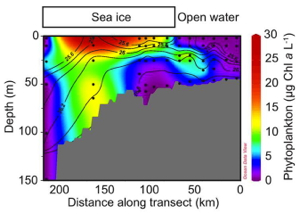 Because these fast-growing phytoplankton consume large
amounts of carbon dioxide, the study concludes that scientists will have to
reassess the amount of carbon dioxide entering the Arctic Ocean through
biological activity if the under-ice blooms turn out to be common. Carbon that
is moved from the atmosphere to the seafloor by this “biological pump” contributes
nothing to current global warming.
Because these fast-growing phytoplankton consume large
amounts of carbon dioxide, the study concludes that scientists will have to
reassess the amount of carbon dioxide entering the Arctic Ocean through
biological activity if the under-ice blooms turn out to be common. Carbon that
is moved from the atmosphere to the seafloor by this “biological pump” contributes
nothing to current global warming.
The discovery of these previously unknown under-ice blooms also has implications for the broader Arctic ecosystem, including migratory species such as whales and birds. Phytoplankton are eaten by small ocean animals, which are eaten by larger fish and ocean animals. A change in the timeline of the blooms can cause disruptions for larger animals that feed either on phytoplankton or on the creatures that eat these microorganisms. "It could make it harder and harder for migratory species to time their life cycles to be in the Arctic when the bloom is at its peak," Arrigo said. "If their food supply is coming earlier, they might be missing the boat."
VIMS professor Deborah Bronk is currently studying these types of polar ecosystem changes, using funding from the National Science Foundation to conduct a three-year study of how changes in the extent and duration of sea ice might affect the supply of nutrients that supports the Chukchi Sea’s coastal ecosystem and the food web on which native peoples depend.
What about Antarctica?
Smith says it’s unlikely that under-ice blooms like those discovered by the ICESCAPE researchers might also be found in Antarctica. “In my experience,” says Smith, “one of the big differences between the poles is that Arctic ice is characterized by melt-water ponds, which increase its transparency. But I’ve never seen melt-water ponds in Antarctica, likely because the air temperatures are too cold.” He adds, however, “we just can’t be sure, and we can all be surprised.”
Perovich agrees with Smith’s assessment, and adds a similar cautionary note. He says “My initial reaction would be that there isn’t sufficient light [for under-ice blooms in Antarctica],” but “if you would have asked us a year ago, we would have said the same thing about the Arctic.”

